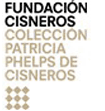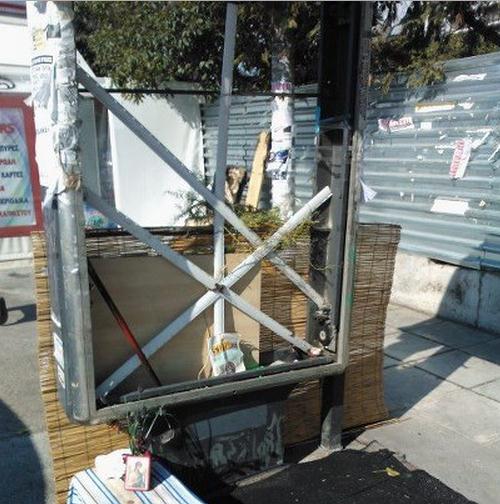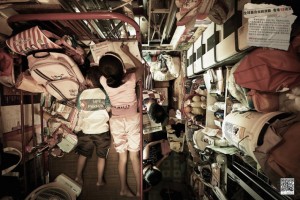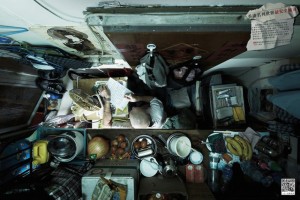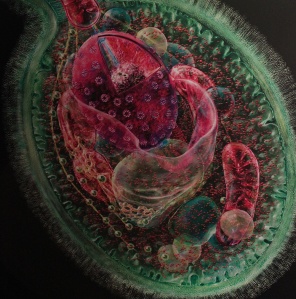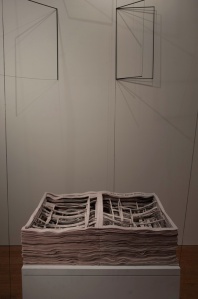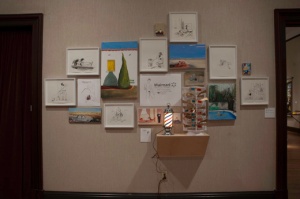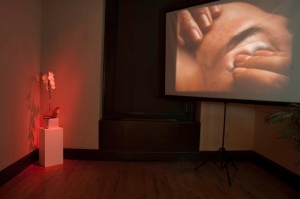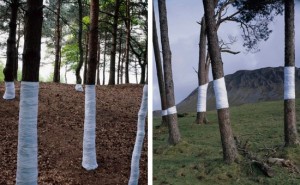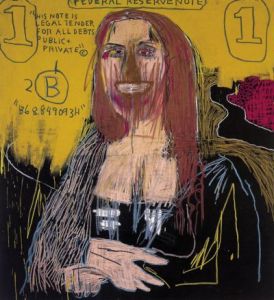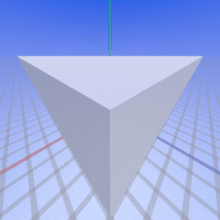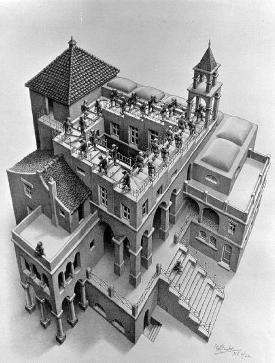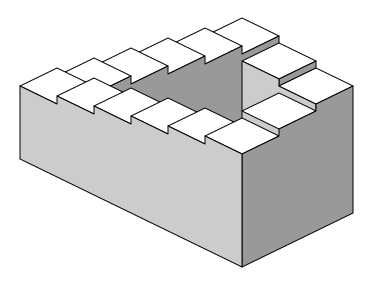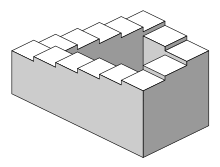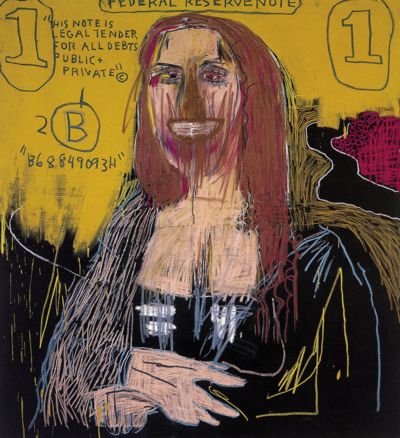Antonio Dias (Brazil, born 1944, lives in Rio de Janeiro, Cologne, and Milan).
Do It Yourself: Freedom Territory, 1968. Adhesive vinyl on floor; overall dimensions variable. Daros Latinamerica Collection, Zürich
Open Work in Latin America, New York & Beyond
Conceptualism Reconsidered, 1967–1978
February 8 – May 4, 2013
THE BERTHA AND KARL LEUBSDORF ART GALLERY
CUNY Hunter College
West Building at the southwest corner of 68th Street
and Lexington Avenue, New York, NY
Gallery Hours: Tuesday through Saturday, 1-6pm
212.772.4991 www.hunter.cuny.edu/art/galleries
Eco’s concept of the Open Work—an artwork that could not be completed without the viewer’s participation—was highly useful for Latin American conceptualists from the late 1960s through the 1970s because it named the collaborative and performative emphasis of their artworks. Open Work in Latin America, New York & Beyond: Conceptualism Reconsidered, 1967–1978 displays the capacious nature of conceptualism by exhibiting 91 books, video, sound, prints, drawings, installations and photography by 36 artists working in Buenos Aires, Rio de Janeiro, New York, London, Los Angeles, Montevideo and Caracas. Although not a historical survey, the show presents a collective desire to use the body to destabilize systems of representation shared by artists from Latin America working in conceptual modes from 1967 to 1978.
Open Work in Latin America, New York and Beyond includes some ninety works that have been generously lent to Hunter College from the Colección Patricia Phelps de Cisneros, The Museum of Modern Art, The Metropolitan Museum of Art, Henrique Faria Fine Art, Document Art Gallery, and Alexander Gray Associates.
Hunter College is deeply grateful to the following donors, whose generous support has made this exhibition possible, Colección Patricia Phelps de Cisneros and The Bershad Exhibition Fund.
The exhibition features works by:
Diego Barboza
Artur Barrio
Luis Benedit
Mel Bochner
Donald Burgy
Luis Camnitzer
Sigfredo Chacón
Eduardo Costa
Jaime Davidovich
Iole de Freitas
Antonio Dias
Juan Downey
Felipe Ehrenberg
Rafael Ferrer
Anna Bella Geiger
Rubens Gerchman
Víctor Grippo
Leandro Katz
Joseph Kosuth
David Lamelas
Sol LeWitt
Lucy Lippard
Cildo Meireles
Ana Mendieta
Marta Minujín
Hélio Oiticica
Clemente Padín
Claudio Perna
John Perreault
Liliana Porter
Alejandro Puente
Carlos Rojas
Ed Ruscha
Bernardo Salcedo
Lawrence Weiner
Horacio Zabala
Supplementary Programming:
Friday March 8
Featuring David Lamelas performing his work Time
Friday, March 15
Including keynote speaker, Dr. Daniel R. Quiles, Department of Art History, Theory and Criticism, School of the Art Institute of Chicago
Wednesday, March 20
Gabriela Rangel, Director of Visual Arts and Curator, Americas Society, New York
MEDIA CONTACT
For additional information, images, or to request an interview please contact:
Andy Cushman | Octopus Outreach | E ac@8op.us | M 917-714-4402
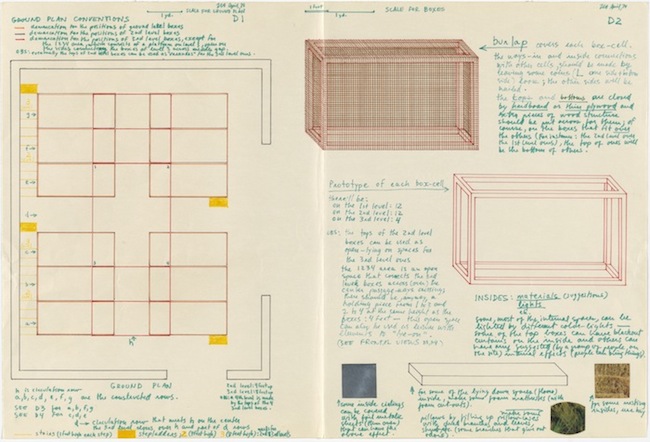
Hélio Oiticica (Brazilian, 1937–1980). Plans for Barracao Experiment 2 (related to former Nests experiments), included in the Museum of Modern Art’s 1970 exhibition “Information,” 1970. Digital Image © The Museum of Modern Art/Licensed by SCALA / Art Resource, NY
Extended Wall Texts from Exhibition by students:
Artur Barrio (Brazil, born 1945, lives in Amsterdam, Aix-en-Provence, and Rio de Janeiro)
P—H—1969Rio de Janeiro: Artur Barrio, 1969
The Museum of Modern Art Library, New York Often working with perishable materials such as raw meat, toilet paper, and garbage, in this artist’s book Barrio records his action of throwing toilet paper (papel higiênico in Portuguese) into the gardens of Rio de Janeiro’s Museum of Modern Art and the nearby ocean. By referencing filth as well as the poetics of space, he both critiques the institution and seeks to provoke a sensorial response.
– Margeaux Walter
Antonio Dias (Brazil, born 1944, lives in Rio de Janeiro, Cologne, and Milan)
Antonio Dias: Poeta o pornógrafo . . . (Poet or Pornographer . . .)Rio de Janeiro: Museu de Arte Moderna do Rio de Janeiro, 1974
Some Artists Do, Some NotBrescia, Italy: Edizioni Nuovi Strumenti, 1974
The Museum of Modern Art Library, New York
A collection of Dias’s working notes from 1970 to 1974, Some Artists Do, Some Not includes installation sketches, paintings, and films from the series “The Illustration of Art.” In this series, Dias experimented with different media, focusing on the polarities of language to present his often ironic interpretations of the production and consumption of art.
– Margeaux Walter
Juan Downey (Chile, 1940–1993)
A Clean New Race, 1970
Colored pencil, pencil, and gouache on board
The Museum of Modern Art, New York. David Rockefeller Latin American Fund
A part of Downey’s “Life Cycle” series and the only surviving document of an ecosystem he realized in his home, this work explores the “invisible,” cyclical connections among humanity, nature, and technology. Drawing on his architectural background, Downey planned a self-sustaining environment wherein the combination of the natural (sunlight and Chilean fertilizer) and the synthetic (artificial light and engineered plant boxes) provided fresh oxygen and healthy foodstuffs for humans and animals, underscoring the artist’s belief that technology could contribute to a better society.
– Heather Reyes
Juan Downey (Chile, 1940–1993)
Meditation Drawing 4, 16, and 39, 1977
Colored pencil and graphite on paper
Colección Patricia Phelps de Cisneros
Supported by a Guggenheim grant, Downey traveled to the Amazon to live for seven months with the Yanomami tribe. During this time he attempted to draw the impression that lingered in his consciousness immediately following meditative sessions, which he described as “a sphere that shreds light without heat.” The Meditation drawings reflect Downey’s respect for the cyclical Yanomami lifestyle. From their conical, communal living spaces or shabonos to their practice of endocannibalism, the tribe’s “life cycle” relates to the artist’s constructed ecosystems.
– Heather Reyes
Anna Bella Geiger (Brazil, born 1933, lives in Rio de Janeiro)
NearerBrazil: Anna Bella Geiger, 1974
The Museum of Modern Art Library, New York
In the 1970s, Geiger began working with film, photography, and artist books, which were becoming increasingly popular media because they slipped under the radar of censorship in Brazil. Geiger also critiqued how commercial photography and film functioned as façades hiding the reality of everyday life. In Nearer we can see her interest in this dichotomy, as well as in sequence, territory, and identity.
– Margeaux Walter
Artists’ books edited by Jorge Glusberg and published by the Centro de Arte y Comunicación in Buenos Aires:
Mel Bochner (United States, born 1940, lives in New York)
Mel Bochner, 1972
Donald Burgy (United States, born 1937, lives in Wellesley, Massachusetts)
Donald Burgy: Ideas para completar contextos; Contexts Completion IdeasCatalogue for exhibition Art Systems at the Museo de Arte Moderno, Buenos Aires, 1971
Dennis Oppenheim (United States, 1938–2011)
Nueve días con Dennis Oppenheim, Centro de Arte y Comunicación; Nine Days with Dennis Oppenheim, Center of Art and Communication, August 1971
Joseph Kosuth (United States, born 1945, lives in New York and Rome)
Joseph Kosuth—The Sixth Investigation (Art as Idea as Idea): Proposition II [La Sexta Investigación (Arte como idea como idea): Proposición II], June 1971
Bernardo Salcedo (Colombia, 1939–2007)
What is it?; Qué es?: Manual para la nueva vanguardia; Manual for the New Avant-Garde, October 1971
Lawrence Weiner (United States, born 1942, lives in New York)
Lawrence Weiner and Lawrence Weiner: 10 Obras; 10 Works, July 1971
The Museum of Modern Art Library, New York
Founded in 1968 by Jorge Glusberg, Centro de Arte y Comunicación (CAyC) was a multidisciplinary workshop in Buenos Aires, Argentina. During the late 1960s and early ’70s, CAyC’s group of artists produced works focusing on Systems Art. The center and its artists organized exhibitions, staged events, and circulated publications. Glusberg promoted international exchange by publishing artists’ books by Lawrence Weiner, Donald Burgy, Bernardo Salcedo, and Joseph Kosuth, and by his traveling exhibitions of Argentinean conceptualism abroad.
– Jennifer Grimyser
Leandro Katz (Argentina, born 1938, lives in Buenos Aires)
21 Líneas (21 Lines) I and IV, and 21 x 78 characters, 1972
Typewriting on paper
The Museum of Modern Art, New York. Latin American and Caribbean Fund
In his “Typewriter Drawings,” Katz uses English and Spanish to subvert the written word’s ability to convey meaning. “Literature,” he states, “may be any arrangement of words in any order.” Here, Katz scrambles linguistic reasoning by inscribing language into a regimented, geometric plan. The squares of 21 Líneas I and 21 Líneas IV include exactly twenty-one lines of Spanish words measuring twenty-one centimeters long, and 21 x 78 characters combines exactly twenty-one lines of English words each containing seventy-eight characters. Although the blocks of texts are not associative, the words’ juxtapositions encourage each reader to create his or her own accidental narrative. Katz says he wants the color, language, and numerical systems of these drawings to convey a “tropical” and spiritual sensibility distinct from the conceptualism of his peers in the United States.
– Heather Reyes
Stay tuned for the rest of the labels…
1





